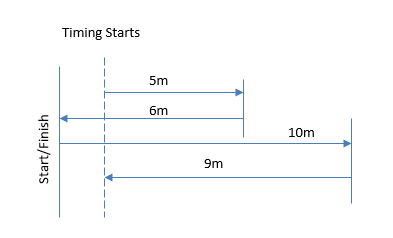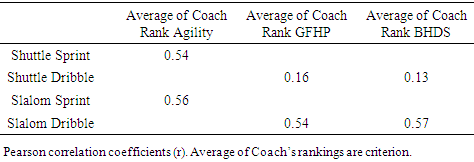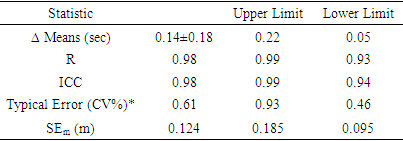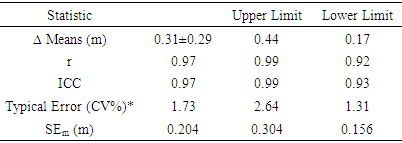-
Paper Information
- Paper Submission
-
Journal Information
- About This Journal
- Editorial Board
- Current Issue
- Archive
- Author Guidelines
- Contact Us
International Journal of Sports Science
p-ISSN: 2169-8759 e-ISSN: 2169-8791
2019; 9(5): 108-113
doi:10.5923/j.sports.20190905.02

The Validity and Reliability of Two Novel Field Hockey Specific Tests among Female Collegiate Field Hockey Athletes
Philip Aumack, Abigail Larson, Mark DeBeliso
Department of Kinesiology and Outdoor Recreation, Southern Utah University, Cedar City, UT, USA
Correspondence to: Mark DeBeliso, Department of Kinesiology and Outdoor Recreation, Southern Utah University, Cedar City, UT, USA.
| Email: |  |
Copyright © 2019 The Author(s). Published by Scientific & Academic Publishing.
This work is licensed under the Creative Commons Attribution International License (CC BY).
http://creativecommons.org/licenses/by/4.0/

Valid and reliable sport specific field tests can be used an indicator of talent potential and to assess skill development. However, many sports including field hockey lack such tests. PURPOSE: The purpose of this study was to determine the reliability and validity of two field hockey specific tests known as the ShuttleSDT and SlalomSDT. METHODS: Fourteen NCAA Division III female field hockey field athletes (age: 19.5±0.8 yrs, height: 1.64±0.05 m, mass: 61.7±7.1 kg) participated in the study. Two familiarization sessions were conducted followed by a familiarizing testing session. The formal testing session then occurred at least 48 hours after all of the familiarization protocols were completed. The formal testing session commenced with a dynamic warm-up after which the athletes completed three trials of the: ShuttleSDT sprint, ShuttleSDT dribble, SlalomSDT sprint, and SlalomSDT dribble. Each trial was separated by a 3-minute rest period. Three coaches completed a questionnaire that ranked each player for metrics of: agility, ball handling and dribbling skill (BHDS), and general field hockey performance (GFHP). The three coach’s ranking for each variable were then averaged and served as the criterion. In order to assess validity, the ShuttleSDT sprint, ShuttleSDT dribble, SlalomSDT sprint and SlalomSDT dribble were then compared to the average of the coaches’ ranking of agility, BHDS, and GFHP. In order to determine the reliability of the tests the best two trial scores were compared with: Pearson Correlation Coefficients (PCC or r), Intraclass Correlation Coefficients (ICC), and ∆ Means. RESULTS: The best two trial scores (seconds) for each test were as follows: ShuttleSDT sprint (TBest=7.40 ±0.33, T2nd=7.48 ± 0.32), ShuttleSDT dribble (TBest=8.38 ± 0.29, T2nd=8.52 ± 0.25), SlalomSDT sprint (TBest=10.49 ±0.72, T2nd=10.63 ± 0.76), and SlalomSDT dribble (TBest=11.37 ± 1.09, T2nd= 11.68 ± 1.13). Moderate significant (p<0.05) correlations were found between the average coaches’ rankings for: agility and Shuttle SDT sprint r=0.54, agility and SlalomSDT sprint r=0.56, BHDS and SlalomSDT dribble r=0.57, & GFHP and SlalomSDT dribble r=0.54. Given the low association between the coaches’ average rankings of BHDS and GFHP and the ShuttleSDT sprint and dribble scores no subsequent reliability analysis for the ShuttleSDT was conducted. The reliability measures for the SlalomSDT sprint best two trial scores were: r=0.98, ICC=0.98, ∆ Means= 0.14±0.18 sec. The reliability measures for the SlalomSDT dribble best two trial scores were: r=0.97, ICC=0.97, ∆ Means= 0.31±0.29 sec. CONCLUSION: Within the parameters of this study, the SlalomSDT assessments were moderately associated with the coaches’ rankings of agility, BHDS, and GFHP. The SlalomSDT assessments were also found to be highly reliable among female collegiate field hockey athletes.
Keywords: Field Hockey, Skill Assessment
Cite this paper: Philip Aumack, Abigail Larson, Mark DeBeliso, The Validity and Reliability of Two Novel Field Hockey Specific Tests among Female Collegiate Field Hockey Athletes, International Journal of Sports Science, Vol. 9 No. 5, 2019, pp. 108-113. doi: 10.5923/j.sports.20190905.02.
Article Outline
1. Introduction
- Field and laboratory performance data are commonly used to distinguish skill levels among athletes. When used appropriately, field and laboratory tests can be used as an indicator of how an athlete may perform in actual competition [6,7]. In sports such as American football and basketball, field and laboratory performance scores are often used as a determining factor for allocating collegiate scholarships and professional draft picks. Coaches and athletes in highly popular sports are able to compare field-testing data to normative values and percentile ranks at many levels of play as well as among males and females. Many less-recognized sports do not have validated sport-specific field and skill tests aimed to evaluate and predict unique performance qualities. Correspondingly, normative data for athletes within less-recognized sports are often lacking. As a result, athletes and coaches are left to utilize tests that may or may not be representative of the most important performance characteristics and have little sport-specific norms in which to compare the assessment results.Limited research has been devoted to describing the performance qualities associated with elite levels of field hockey play. In a study conducted by Podgorski & Pawlak [15] researchers sought to determine the number of studies within various sport categories using the EBSCOhost database. Field hockey was found to have the fewest search results; other sports included in the aforementioned study included football, baseball, basketball, softball, lacrosse, water polo, cricket, volleyball and handball. Researchers concluded that overall there is a lack of comprehensive data on the physiological characteristics associated with high-level field hockey performance and especially so among female athletes [15,16]. Additionally, Rhea and Peterson [17], in their widely read and referred to NSCA's Guide to Tests and Assessments text, reported no normative values for field hockey athletes for the T-test, pro-agility, three cone drill, Edgren, or Hexagon test.Despite a general dearth of field hockey research, the general sport demands have been previously examined by at least a few researchers. Lothian et al. [14] noted up to 30% of game time, which is divided into two 35-minute halves, is spent sprinting for the ball or dribbling the ball. Gameplay also requires athletes to sprint numerous times. When defined as repeating a sprint within twenty-one seconds of another sprint, it was recorded that seventeen sprints were accumulated in the duration of a game [19,20]. Change of direction speed is also important to field hockey performance, as top players distinguish themselves from other players by dribbling and evading opponents [16]. Athletes who develop the technical skills to perform these activities with possession of the ball typically end up playing at higher levels than those who do not. Additional measured variables that distinguish regional field hockey athletes from club level field hockey athletes include percent body fat, sprint speed, aerobic endurance, lower body muscular power, agility, dribbling control, and shooting accuracy [6,7]. Many physical performance tests have been designed to measure physiological characteristics that may influence sport performance. Field hockey requires sprinting, rapid change of direction as well as stick and ball handling skills. To date there are only two field tests that specifically address all of these components, the Shuttle sprint and dribble test (ShuttleSDT) and Slalom sprint and dribble test, (SlalomSDT) [12,13]. These tests can be used to measure the ability of a field hockey athlete to sprint and change direction both with and without the ball.Performance results for the SlalomSDT have been used to discriminate between elite and non-elite youth field hockey players [7]. Field hockey players who played for a national prestige club were divided into elite and sub-elite categories for selection to the Dutch Field Hockey Association team. Thirty-eight elite and 88 sub-elite athletes were tested in the ShuttleSDT, SlalomSDT, Interval Shuttle Run Test, a pilot Tactical Questionnaire, and the Psychological Skill Inventory for Sports questionnaire (PSIS). The elite athletes scored statistically better than the sub-elite athletes on all assessments [7]. Lemmink, Elferink-Gemser, and Visscher [7] examined the ShuttleSDT and SlalomSDT and determined that the both tests were reliable measures of field hockey skill, agility and speed performance in a sample of 34 adolescent field hockey players. However, to the best of our knowledge these tests have not yet been validated in an adult population of experienced field hockey players. Therefore, the purpose of the current study was to examine the validity and reliability of the ShuttleSDT and SlalomSDT among collegiate division III female field-hockey players. The results of the ShuttleSDT and SlalomSDT were compared to coaches’ rankings of player field hockey abilities in: 1) acceleration, deceleration and change direction speed (agility); 2) ball handling and dribbling skill (BHDS); and 3) general field hockey performance (GFHP). Intra-session ShuttleSDT and SlalomSDT reliability was examined in a manner consistent with prior reliability investigations [1,5,21,22].It was hypothesized that there would be a strong relationship between ShuttleSDT and coaches’ rankings of agility, BHDS, and GFHP. Likewise, it was hypothesized that there would be a strong relationship between SlalomSDT and coaches’ rankings of agility, BHDS, and GFHP. Finally, it was hypothesized that both the ShuttleSDT and SlalomSDT would have high intra-session test-retest reliability.
2. Methods
2.1. Participants
- Fourteen NCAA Division III female field hockey athletes participated in this study. Average field hockey experience was 9.2±2.1 years. All participants went through a clearance procedure to participate in sporting activities with their assigned athletic trainer. Participation was voluntary and all were given time to read and sign a consent form. This study was reviewed and approved by the Southern Utah University Institutional Review Board to ensure ethical standards were met, and safety of the participants was the highest priority.
2.2. Instruments and Apparatus
- The participants completed the Shuttle and Slalom sprint and dribble trials on outdoor artificial turf. Normal training footwear was worn during the trials and weather conditions ranged from 50-60°F for each testing day. The Shuttle and Slalom courses were marked using 6-inch rubber cones (see Figures 1 and 2). Time to complete each trial was measured with a MARATHON Adanac 4000 digital stopwatch. The study was conducted using NCAA regulatory compliant field hockey balls and sticks.
 | Figure 1. ShuttleSDT Course for Sprint and Dribble Trials (Lemmink, 2004) |
 | Figure 2. SlalomSDT Course for Sprint and Dribble Trials (Lemmink, 2004) |
2.3. Procedures
- Prior to data collection all volunteers participated in two untimed familiarization sessions. Each session was separated by 48 hours. Familiarization sessions involved a dynamic warm up, followed by a verbal description and physical demonstration of each test (ShuttleSDT, and SlalomSDT) after which, participants completed three practice trials of the ShuttleSDT and SlalomSDT. For the first three trials of each test participants held their sticks (sprint trials) then for the next three trials participants dribbled a ball through the course (dribble trials) (12 practice trials total). Throughout the entire session, participants had three minutes of rest between each trial. Exactly one week from the untimed familiarization sessions, a timed familiarization session was conducted. The timed familiarization session commenced in the same format as described for the untimed familiarization sessions. The purpose of timed familiarization session was to prepare the athletes for the actual data collection session of the study.Following the timed familiarization session the official timed session was conducted 48 hours later. The best two trials of the ShuttleSDT sprint, ShuttleSDT dribble, SlalomSDT sprint and SlalomSDT dribble were recorded for subsequent analysis.The ShuttleSDT course requires participants to sprint forward 6m (1m running start) from the start line, followed by 5m back, followed by 10m forward, and finish with 9m back to the start. Total yards traveled in each trial is 32m, a schematic of the ShuttleSDT can be found in Figure 1. Time to complete the course was recorded with a handheld stopwatch. Timing started on subject’s first movement.The ShuttleSDT was executed three times while holding the hockey stick (ShuttleSDT Sprint) then three times while dribbling the ball (ShuttleSDT Dribble). During the ShuttleSDT dribbling trials, participants were instructed that the ball must pass the cones at each distance. The participants were instructed to complete the trial as fast as possible using any dribbling technique that could be used in an actual game. One repeat trial was given if participants lost significant ball control (2m away from themselves). Three minutes separated each trial.The SlalomSDT course is set up with 12 cones, displaced 1m out and 2m wide from each other in zigzag fashion, with total yards traveled equaling 30m (Figure 2). The orientation of the course requires the participant to control posture and change direction multiple times. The SlalomSDT test requires a 1m running start then following the zig-zag patterned course. Time to complete the course was recorded with a handheld stopwatch. Timing started on subject’s first movement. Prior research assessing sprint style field tests with a hand held stop watch have reported good-excellent reliability [21,22].The SlalomSDT was executed three times while holding the hockey stick (SlalomSDT Sprint) then three times while dribbling the ball (SlalomSDT Dribble). During the SlalomSDT dribbling trials, participants were instructed that the ball must travel around each cone and to complete the trial as fast as possible using any dribbling technique that could be used in an actual game. One repeat trial was given if participants lost significant ball control (2m away from themselves). Three minutes separated each trial.A brief survey was given to each field hockey coach (n = 3) to rank the players (from best to worst) based on the three skill measurements; agility, BHDS, and GFHP. Specifically, there were 14 participants, so each coach assigned a unique rank score between 1 and 14 (with 1 being the best score) for each of the three skill measurements. The three coaches’ total field hockey coaching experience ranged from 7-13 years. Experience coaching the participant athletes ranged from 1-4.5 years. All coaches had at least one competitive season’s worth of exposure to the abilities of the athletes.
2.4. Statistical Analysis
2.4.1. Validity
- The three coaches’ rankings were averaged for agility, BHDS and GFHP and served as the criterion measure in order to assess the validity of the ShuttleSDT and SlalomSDT. Pearson correlation coefficients (PCC or r) were then used to compare: the ShuttleSDT sprint, ShuttleSDT dribble, SlalomSDT sprint and SlalomSDT dribble to the average of the coaches’ ranking of agility, BHDS, and GFHP.
2.4.2. Reliability
- There is ongoing discussion regarding the most appropriate manner to evaluate the reliability of a test [3,4,10,11,18]. Hence, a host of different strategies were employed to determine the intra-session reliability of the ShuttleSDT sprint, ShuttleSDT dribble, SlalomSDT sprint and SlalomSDT dribble tests. The best two trial scores of the ShuttleSDT sprint, ShuttleSDT dribble, SlalomSDT sprint and SlalomSDT dribble were used to explore the reliability of each of the tests.The analysis included: a visual inspection of the degree of linearity between trials (scatter plot), interclass (Pearson’s r) reliability coefficients, intraclass reliability coefficients (ICC), mean difference between trials, the standard error of measurement (SEm), and the coefficient of variation percent (CV%) based on log-transformed trial data. A visual inspection of Bland-Altman plots was also conducted in order to examine error uniformity. The reliability analysis was conducted with Microsoft Excel including the use of a spreadsheet prepared by Hopkins [9]. The Excel spread sheet of data was peer reviewed for accuracy as advocated by AlTarawneh and Thorne [2].
3. Results
- Fourteen female NCAA Division III Field Hockey athletes completed all trials in the practice and testing session. The averages for age, height, and body mass can be found in Table 1. Each of the participants completed the trials without injury or incident.
|
|
|
|
|
|
4. Discussion
- The purpose of this study was to determine the validity and reliability of the ShuttleSDT and SlalomSDT field tests in a population of collegiate, division III, female field-hockey players. Criterion based validity was to be assessed by comparing the ShuttleSDT and SlalomSDT scores with coaches’ performance rankings of agility, GFHP, and BHDS. It was hypothesized that both the ShuttleSDT and SlalomSDT field tests would yield a strong relationship with the coaches’ rankings of agility, GFHP, and BHDS. Secondly, it was hypothesized that the intra-session test-retest reliability would be high for both ShuttleSDT and SlalomSDT field tests. The validity of the ShuttleSDT dribble test fell in the low range (0.13-0.16) for GFHP and BHDS. The validity of the SlalomSDT sprint and dribble tests were in the moderate range (0.54- 0.57) for agility, GFHP and BHDS. Given the low validity for the Shuttle SDT dribble test a subsequent reliability analysis was not warranted for the ShuttleSDT. The reliability analysis for the SlalomSDT sprint and dribble tests yielded ICCs and interclass reliability coefficients (r) ranging from 0.97-0.98. ICCs of this magnitude are considered as “excellent reliability” [11]. The interclass reliability coefficients (r) of this magnitude are consistent with test-retest reliability coefficients reported for commonly used physical performance tests [18].The data from this study may be used as the beginning of a collection of normative data values for female collegiate field-hockey athletes. Additionally, if found to be related to performance, these tests may also be used to identify potentially talented field hockey athletes, as a measure of performance improvement, or as drills to practice ball handling and change of direction skills. With that said, we cannot support the use of the ShuttleSDT due to such low criterion based validity. The findings of the current study agree with the field test originators’, indicating that the SlalomSDT tests are reliable [12] among teen age male and female field hockey athletes. However the results of the current study do not support the use of the ShuttleSDT as suggested by Lemmink [12]. It is possible that allowing for additional familiarization trials could have yielded a stronger criterion validity for the ShuttleSDT in the current study.Overall, the coaches’ ranking of each skill measure for the Slalom SDT sprint and dribble tests were moderately consistent. It was expected that the coaches’ ranking of agility would correlate well with the Slalom sprint scores, which was moderately the case (r=0.56, p<0.05). It was also expected that the coaches’ rankings of GFHP and BHDS would correlate well with SlalomSDT dribble scores, again, this was moderately the case (r =0.54, 0.57) respectively.The dribbling performance during the SlalomSDT dribble test may be a good indicator of GFHP and BHDS given multiple exposures to the test. It is also important to note that other factors that influence GFHP include; tactical decision-making ability, shooting accuracy, confidence, motivation, and endurance capacity which were not assessed during these tests.This study has notable strengths, particularly, the ease of implementation of the SlalomSDT into a strength and conditioning sessions or sport practice. The SlalomSDT requires little equipment and space. The SlalomSDT field tests could be used to expose and address weaknesses in an athlete’s ball control and/or speed. For example, the time differential between the sprint and dribble trials maybe used as a gauge to determine weakness in ball handling ability (where greater time differentials may suggest a ball handling weakness). As this study is repeated, data will build a case to support or contradict the use of the SlalomSDT to evaluate field hockey ability. Coaches can also use the SlalomSDT as a progressive measurement, as lower times in either sprint or dribble trials would indicate an improvement in either speed, ball handling skill, acceleration, deceleration, and change of direction, or multiple areas. Finally, all of the participants completed the study with no injury or withdrawals for any reason.Weak points of this study include potential bias during the ranking of participants, which could have been influenced by likeability. The coaches’ rankings, if biased, may have in turn impacted the criterion validity assessments of both ShuttleSDT and the SlalomSDT. The reliability assessments may have been affected by the familiarization sessions. However, the reliability coefficients (r, ICC) were very high for both the SlalomSDT sprint and dribble scores, suggesting that sufficient familiarization had taken place. Another weak point in the study has to do with the test sessions which may have been exhaustive for some, involving 12 trials total throughout the session (3 running, 3 dribbling for each ShuttleSDT and SlalomSDT). Based on the finding of this study, we suggest that only the Slalom SDT be implemented, which in turn would reduce the trials by 50% (i.e. mitigating the exhaustion issue). Finally, this study sample only represents a rather small portion of the population investigated (one field hockey team out of the entire NCAA Division III level).Future research may look to replicate this study with larger sample sizes and potentially with Lacrosse athletes. Data collected in a replication of the current study could also add to the data collected in the current study for the purpose of establishing a normative database as in [8]. Other studies may examine the effects of strength and conditioning programs on the SlalomSDT sprint and dribble test times.As mentioned earlier, many professional organizations have a battery of assessments that recognize certain physical/motor attributes associated with success in that sport. In order to elevate and facilitate skill development, other sports (i.e. field hockey) should be armed with valuable assessment tools. The findings of this study are promising regarding the positive relationship between performance of the Slalom SDT and coaches’ rankings of field hockey skills.
5. Conclusions
- Given the parameters used in this study, the SlalomSDT sprint and dribble tests should be considered as moderately valid but highly reliable tests of field hockey performance measures of agility, GFHP, and BHDS. The SlalomSDT tests require inexpensive equipment and minimal open space to perform, making them a useful assessment tool to implement. It is recommended that sport coaches and strength and conditioning coaches use the SlalomSDT sprint and dribble tests when evaluating agility, GFHP and BHDS among female collegiate field hockey players.
 Abstract
Abstract Reference
Reference Full-Text PDF
Full-Text PDF Full-text HTML
Full-text HTML




